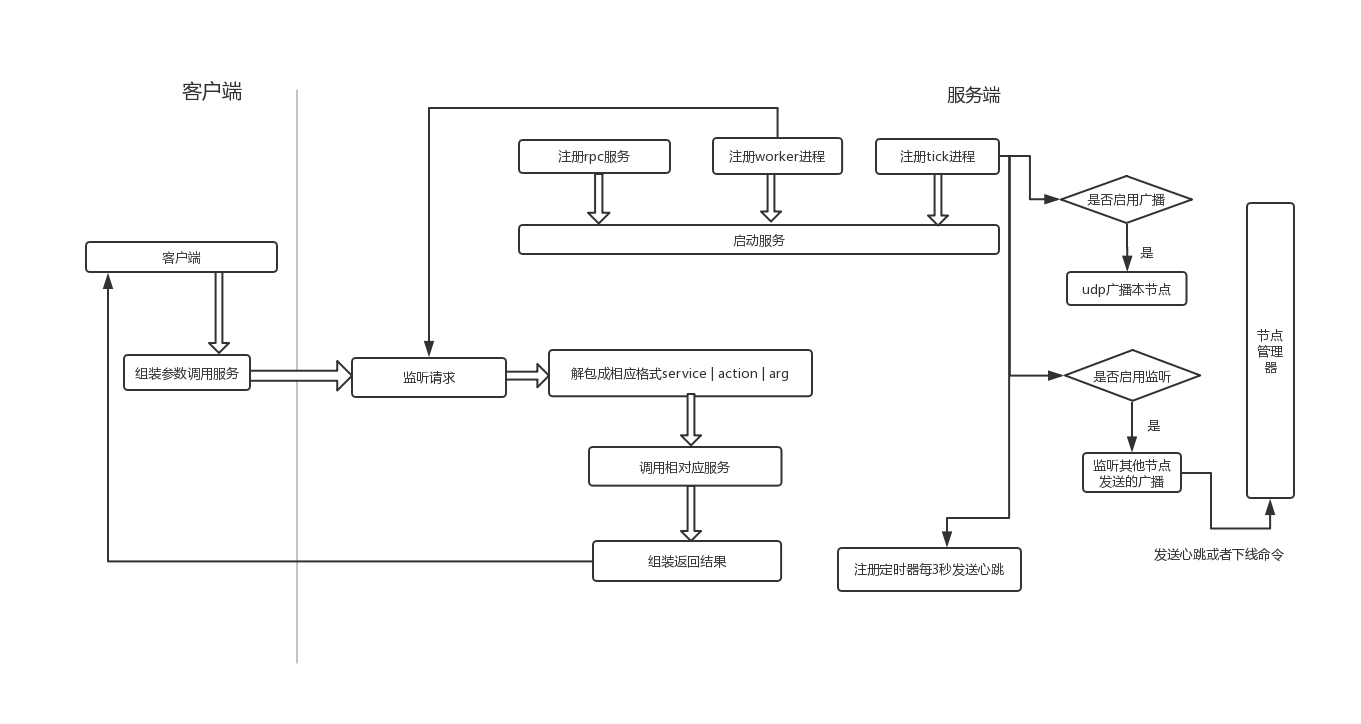EasySwoole RPC
很多传统的 Phper 并不懂 RPC 是什么,RPC 全称 Remote Procedure Call,中文译为 远程过程调用,其实你可以把它理解为是一种架构性上的设计,或者是一种解决方案。
例如在某庞大商场系统中,你可以把整个商场拆分为 N 个微服务(理解为 N 个独立的小模块也行),例如:
- 订单系统
- 用户管理系统
- 商品管理系统
- 等等
那么在这样的架构中,就会存在一个 API 网关 的概念,或者是叫 服务集成者。我的 API 网关 的职责,就是把一个请求,拆分成 N 个小请求,分发到各个小服务里面,再整合各个小服务的结果,返回给用户。例如在某次下单请求中,那么大概发送的逻辑如下:
- API 网关接受请求
- API 网关提取用户参数,请求用户管理系统,获取用户余额等信息,等待结果
- API 网关提取商品参数,请求商品管理系统,获取商品剩余库存和价格等信息,等待结果
- API 网关融合用户管理系统、商品管理系统的返回结果,进行下一步调用(假设满足购买条件)
- API 网关调用用户管理信息系统进行扣款,调用商品管理系统进行库存扣减,调用订单系统进行下单(事务逻辑和撤回可以用
请求 id保证,或者自己实现其他逻辑调度) - API 网关返回综合信息给用户
而在以上发生的行为,就称为 远程过程调用。而调用过程实现的通讯协议可以有很多,比如常见的 HTTP 协议。而 EasySwoole RPC 采用自定义短链接的 TCP 协议实现,每个请求包,都是一个 JSON,从而方便实现跨平台调用。
全新特性
- 协程调度
- 服务自动发现
- 服务熔断
- 服务降级
- Openssl 加密
- 跨平台、跨语言支持
- 支持接入第三方注册中心
安装
composer require easyswoole/rpc=4.x
执行流程
服务端:
注册RPC服务,创建相应的服务swoole table表(ps:记录调用成功和失败的次数)
注册worker,tick进程
woker进程监听:
客户端发送请求->解包成相对应的格式->执行对应的服务->返回结果->客户端
tick进程:
注册定时器发送心跳包到本节点管理器
启用广播:每隔几秒发送本节点各个服务信息到其他节点
启用监听:监听其他节点发送的信息,发送相对应的命令(心跳|下线)到节点管理器处理
进程关闭:主动删除本节点的信息,发送下线广播到其他节点

Rpc-Server
场景
例如在一个商场系统中,我们将商品库和系统公告两个服务切分开到不同的服务器当中。当用户打开商场首页的时候, 我们希望App向某个网关发起请求,该网关可以自动的帮我们请求商品列表和系统公共等数据,合并返回。
服务定义
每一个Rpc服务其实就一个EasySwoole\Rpc\AbstractService类。 如下:
定义商品服务
namespace App\RpcService;
use EasySwoole\Rpc\AbstractService;
class Goods extends AbstractService
{
/**
* 重写onRequest(比如可以对方法做ip拦截或其它前置操作)
*
* @param string $action
* @return bool
* CreateTime: 2020/6/20 下午11:12
*/
protected function onRequest(?string $action): ?bool
{
return true;
}
public function serviceName(): string
{
return 'goods';
}
public function list()
{
$this->response()->setResult([
[
'goodsId'=>'100001',
'goodsName'=>'商品1',
'prices'=>1124
],
[
'goodsId'=>'100002',
'goodsName'=>'商品2',
'prices'=>599
]
]);
$this->response()->setMsg('get goods list success');
}
}定义公共服务
namespace App\RpcService;
use EasySwoole\Rpc\AbstractService;
class Common extends AbstractService
{
public function serviceName(): string
{
return 'common';
}
public function mailBox()
{
$this->response()->setResult([
[
'mailId'=>'100001',
'mailTitle'=>'系统消息1',
],
[
'mailId'=>'100001',
'mailTitle'=>'系统消息1',
],
]);
$this->response()->setMsg('get mail list success');
}
public function serverTime()
{
$this->response()->setResult(time());
$this->response()->setMsg('get server time success');
}
}服务注册
在Easyswoole全局的Event文件中,进行服务注册。至于节点管理、服务类定义等具体用法请看对应章节。
namespace EasySwoole\EasySwoole;
use App\RpcService\Common;
use App\RpcService\Goods;
use EasySwoole\EasySwoole\Swoole\EventRegister;
use EasySwoole\EasySwoole\AbstractInterface\Event;
use EasySwoole\Http\Request;
use EasySwoole\Http\Response;
use EasySwoole\Redis\Config\RedisConfig;
use EasySwoole\RedisPool\RedisPool;
use EasySwoole\Rpc\NodeManager\RedisManager;
use EasySwoole\Rpc\Config as RpcConfig;
use EasySwoole\Rpc\Rpc;
class EasySwooleEvent implements Event
{
public static function initialize()
{
// TODO: Implement initialize() method.
date_default_timezone_set('Asia/Shanghai');
}
public static function mainServerCreate(EventRegister $register)
{
/*
* 定义节点Redis管理器
*/
$redisPool = new RedisPool(new RedisConfig([
'host'=>'127.0.0.1'
]));
$manager = new RedisManager($redisPool);
//配置Rpc实例
$config = new RpcConfig();
//这边用于指定当前服务节点ip,如果不指定,则默认用UDP广播得到的地址
$config->setServerIp('127.0.0.1');
$config->setNodeManager($manager);
/*
* 配置初始化
*/
Rpc::getInstance($config);
//添加服务
Rpc::getInstance()->add(new Goods());
Rpc::getInstance()->add(new Common());
Rpc::getInstance()->attachToServer(ServerManager::getInstance()->getSwooleServer());
}
public static function onRequest(Request $request, Response $response): bool
{
// TODO: Implement onRequest() method.
return true;
}
public static function afterRequest(Request $request, Response $response): void
{
// TODO: Implement afterAction() method.
}
}为了方便测试,我把两个服务放在同一台机器中注册。实际生产场景应该是N台机注册商品服务,N台机器注册公告服务,把服务分开。
Rpc-Client
控制器聚合调用
namespace App\HttpController;
use EasySwoole\Http\AbstractInterface\Controller;
use EasySwoole\Rpc\Response;
use EasySwoole\Rpc\Rpc;
class Index extends Controller
{
function index()
{
$ret = [];
$client = Rpc::getInstance()->client();
/*
* 调用商品列表
*/
$client->addCall('goods','list',['page'=>1])
->setOnSuccess(function (Response $response)use(&$ret){
$ret['goods'] = $response->toArray();
})->setOnFail(function (Response $response)use(&$ret){
$ret['goods'] = $response->toArray();
});
/*
* 调用信箱公共
*/
$client->addCall('common','mailBox')
->setOnSuccess(function (Response $response)use(&$ret){
$ret['mailBox'] = $response->toArray();
})->setOnFail(function (Response $response)use(&$ret){
$ret['mailBox'] = $response->toArray();
});
/*
* 获取系统时间
*/
$client->addCall('common','serverTime')
->setOnSuccess(function (Response $response)use(&$ret){
$ret['serverTime'] = $response->toArray();
});
$client->exec(2.0);
$this->writeJson(200,$ret);
}
}注意,控制器中可以这样调用,是因为服务端章节中,在EasySwoole的全局启动事件已经对当前的Rpc实例定义注册了节点管理器。因此在控制器中调用的时候 该Rpc实例可以找到对应的节点。一般来说,在做聚合网关的节点,是不需要注册服务进去的,仅需注册节点管理器即可。
客户端
当rpc服务和客户端不在同一服务中时,并且服务端客户端使用的都是es
<?php
require_once 'vendor/autoload.php';
use EasySwoole\Rpc\Config;
use EasySwoole\Rpc\Rpc;
use EasySwoole\Rpc\NodeManager\RedisManager;
use EasySwoole\Rpc\Response;
$redisConfig = new \EasySwoole\Redis\Config\RedisConfig();
$redisConfig->setHost('127.0.0.1'); // 服务端使用的redis节点地址
$redisConfig->setPort('6379'); // 服务端使用的redis节点端口
$pool=new \EasySwoole\RedisPool\RedisPool($redisConfig);
$config = new Config();
$config->setServerIp('127.0.0.1'); // 指定rpc服务地址
$config->setListenPort(9502); // 指定rpc服务端口
$config->setNodeManager(new RedisManager($pool));
$rpc = new Rpc($config);
\Swoole\Coroutine::create(function () use ($rpc) {
$client = $rpc->client();
$client->addCall('UserService', 'register', ['arg1', 'arg2'])
->setOnFail(function (Response $response) {
print_r($response->toArray());
})
->setOnSuccess(function (Response $response) {
print_r($response->toArray());
});
$client->exec();
});
swoole_timer_clear_all();跨平台
Rpc的请求响应通过tcp协议,服务广播使用udp协议,我们只需要实现网络协议即可。
PHP示例代码
<?php
/**
* Created by PhpStorm.
* User: xcg
* Date: 2019/6/17
* Time: 14:30
*/
$data = [
'command' => 1,//1:请求,2:状态rpc 各个服务的状态
'request' => [
'serviceName' => 'UserService',
'action' => 'register',//行为名称
'arg' => [
'args1' => 'args1',
'args2' => 'args2'
]
]
];
//$raw = serialize($data);//注意序列化类型,需要和RPC服务端约定好协议 $serializeType
$raw = json_encode($data, JSON_UNESCAPED_UNICODE | JSON_UNESCAPED_SLASHES);
$fp = stream_socket_client('tcp://127.0.0.1:9600');
fwrite($fp, pack('N', strlen($raw)) . $raw);//pack数据校验
$data = fread($fp, 65533);
//做长度头部校验
$len = unpack('N', $data);
$data = substr($data, '4');
if (strlen($data) != $len[1]) {
echo 'data error';
} else {
$data = json_decode($data, true);
// //这就是服务端返回的结果,
var_dump($data);//默认将返回一个response对象 通过$serializeType修改
}
fclose($fp);Go示例代码
package main
import (
"encoding/binary"
"net"
)
func main() {
var tcpAddr *net.TCPAddr
tcpAddr,_ = net.ResolveTCPAddr("tcp","127.0.0.1:9600")
conn,_ := net.DialTCP("tcp",nil,tcpAddr)
defer conn.Close()
sendEasyswooleMsg(conn)
}
func sendEasyswooleMsg(conn *net.TCPConn) {
var sendData []byte
data := `{"command":1,"request":{"serviceName":"UserService","action":"register","arg":{"args1":"args1","args2":"args2"}}}`
b := []byte(data)
// 大端字节序(网络字节序)大端就是将高位字节放到内存的低地址端,低位字节放到高地址端。
// 网络传输中(比如TCP/IP)低地址端(高位字节)放在流的开始,对于2个字节的字符串(AB),传输顺序为:A(0-7bit)、B(8-15bit)。
sendData = int32ToBytes8(int32(len(data)))
// 将数据byte拼装到sendData的后面
for _, value := range b {
sendData = append(sendData, value)
}
conn.Write(sendData)
}
func int32ToBytes8(n int32) []byte {
var buf = make([]byte, 4)
binary.BigEndian.PutUint32(buf, uint32(n))
return buf
}Java
import java.io.IOException;
import java.io.InputStream;
import java.io.OutputStream;
import java.net.Socket;
public class Main {
public static void main(String[] args) throws IOException {
byte[] msg = "{\"command\":1,\"request\":{\"serviceName\":\"UserService\",\"action\":\"register\",\"arg\":{\"args1\":\"args1\",\"args2\":\"args2\"}}}".getBytes();
byte[] head = Main.toLH(msg.length);
byte[] data = Main.mergeByteArr(head, msg);
//创建Socket对象,连接服务器
Socket socket=new Socket("127.0.0.1",9600);
//通过客户端的套接字对象Socket方法,获取字节输出流,将数据写向服务器
OutputStream out=socket.getOutputStream();
out.write(data);
//读取服务器发回的数据,使用socket套接字对象中的字节输入流
InputStream in=socket.getInputStream();
byte[] response=new byte[1024];
int len=in.read(response);
System.out.println(new String(response,4, len-4));
socket.close();
}
static byte[] toLH(int n) {
byte[] b = new byte[4];
b[3] = (byte) (n & 0xff);
b[2] = (byte) (n >> 8 & 0xff);
b[1] = (byte) (n >> 16 & 0xff);
b[0] = (byte) (n >> 24 & 0xff);
return b;
}
static byte[] mergeByteArr(byte[] a, byte[] b) {
byte[] c= new byte[a.length + b.length];
System.arraycopy(a, 0, c, 0, a.length);
System.arraycopy(b, 0, c, a.length, b.length);
return c;
}
}其他语言只需要实现tcp协议即可
EasySwoole RPC 自定义注册中心
EasySwoole默认为通过UDP广播+自定义进程定时刷新自身节点信息的方式来实现无主化/注册中心的服务发现。在服务正常关闭的时候,自定义定时进程的onShutdown方法会执行deleteServiceNode方法来实现节点下线。在非正常关闭的时候,心跳超时也会被节点管理器踢出。
有些情况,不方便用UDP广播的情况下,那么EasySwoole支持你自定义一个节点管理器,来变更服务发现方式。
例如用Redis来实现
namespace EasySwoole\Rpc\NodeManager;
use EasySwoole\RedisPool\RedisPool;
use EasySwoole\Rpc\ServiceNode;
use EasySwoole\Utility\Random;
class RedisManager implements NodeManagerInterface
{
protected $redisKey;
protected $pool;
function __construct(RedisPool $pool, string $hashKey = 'rpc')
{
$this->redisKey = $hashKey;
$this->pool = $pool;
}
function getServiceNodes(string $serviceName, ?string $version = null): array
{
$redis = $this->pool->getObj(15);
try {
$nodes = $redis->hGetAll("{$this->redisKey}_{$serviceName}");
$nodes = $nodes ?: [];
$ret = [];
foreach ($nodes as $nodeId => $node) {
$node = new ServiceNode(json_decode($node,true));
/**
* @var $nodeId
* @var ServiceNode $node
*/
if (time() - $node->getLastHeartBeat() > 30) {
$this->deleteServiceNode($node);
}
if ($version && $version != $node->getServiceVersion()) {
continue;
}
$ret[$nodeId] = $node;
}
return $ret;
} catch (\Throwable $throwable) {
//如果该redis断线则销毁
$this->pool->unsetObj($redis);
} finally {
$this->pool->recycleObj($redis);
}
return [];
}
function getServiceNode(string $serviceName, ?string $version = null): ?ServiceNode
{
$list = $this->getServiceNodes($serviceName, $version);
if (empty($list)) {
return null;
}
return Random::arrayRandOne($list);
}
function deleteServiceNode(ServiceNode $serviceNode): bool
{
$redis = $this->pool->getObj(15);
try {
$redis->hDel($this->generateNodeKey($serviceNode), $serviceNode->getNodeId());
return true;
} catch (\Throwable $throwable) {
$this->pool->unsetObj($redis);
} finally {
$this->pool->recycleObj($redis);
}
return false;
}
function serviceNodeHeartBeat(ServiceNode $serviceNode): bool
{
if (empty($serviceNode->getLastHeartBeat())) {
$serviceNode->setLastHeartBeat(time());
}
$redis = $this->pool->getObj(15);
try {
$redis->hSet($this->generateNodeKey($serviceNode), $serviceNode->getNodeId(), $serviceNode->__toString());
return true;
} catch (\Throwable $throwable) {
$this->pool->unsetObj($redis);
} finally {
//这边需要测试一个对象被unset后是否还能被回收
$this->pool->recycleObj($redis);
}
return false;
}
protected function generateNodeKey(ServiceNode $node)
{
return "{$this->redisKey}_{$node->getServiceName()}";
}
}即使关闭了UDP定时广,EasySwoole Rpc的tick进程依旧会每3秒执行一次serviceNodeHeartBeat用于更新自身的节点心跳信息。
